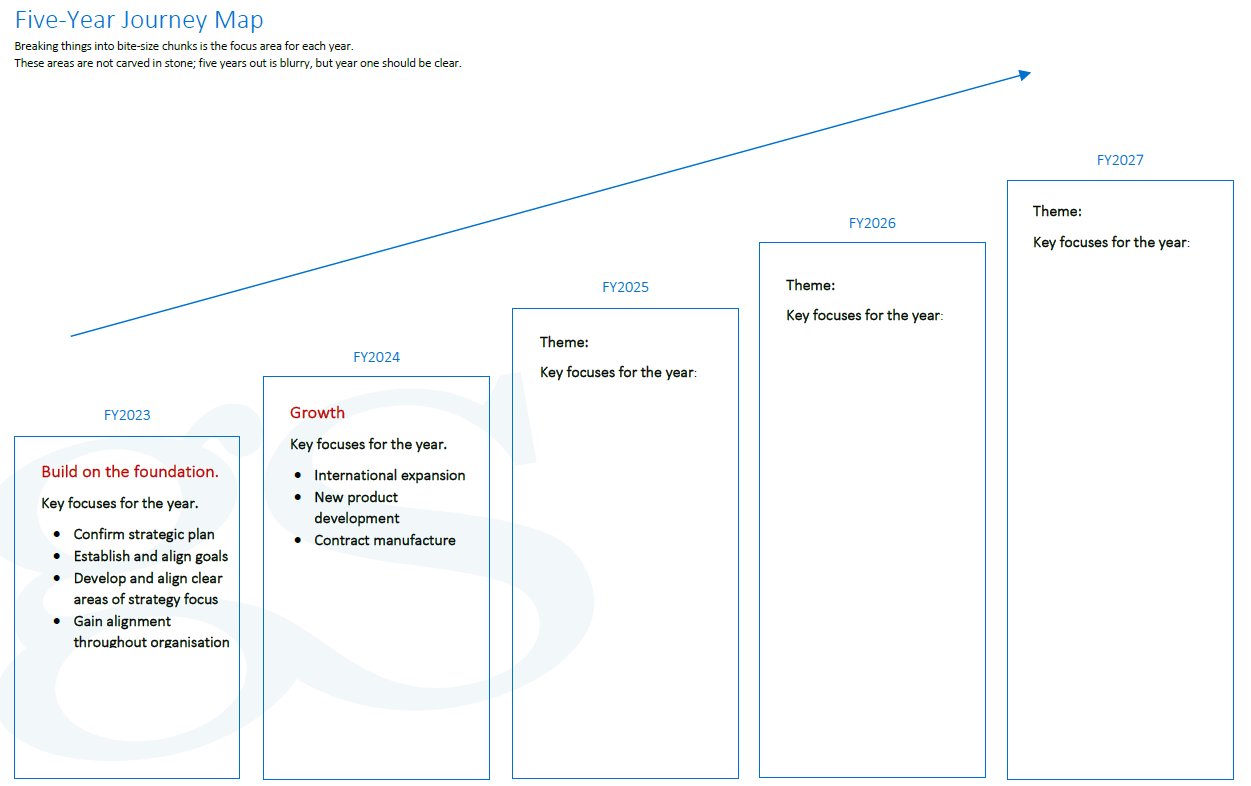We are recognised as authorities in our specialised fields. We publish newsletters with informed opinions that are free for you to subscribe to.
Achieving business goals just got easier.

It’s late in the evening, and the business owner sits alone in their office. The hum of the city outside is a distant murmur, but the weight of the task at hand is prominent. With a heavy sigh, they reach for a meticulously crafted document – their company’s long-term business goals. The pages, once filled with bold aspirations, now seem to echo back at them, asking a daunting question: How am I going to achieve this?
The journey ahead promises a mix of challenges and opportunities that seem both exciting and overwhelming. It’s a familiar moment for any business owner, the intersection of aspirations and the reality of execution, where the path forward seems to blur.
But among the waves of uncertainty, a glimmer of hope emerges. A tool, a guide, a roadmap designed to navigate the twists and turns of long-term business goals. A tool that turns overwhelming visions into achievable steps…
The five-year journey map.
There are a billion models out there on how to set achievable and measurable business goals, but they are pretty quick to overcomplicate things. This journey map allows you to break things into bite-sized chunks.

Each year should have a theme that will provide insight as to what you need to achieve that year. For example, Year 1 (2023) – Theme: building the foundation – then list the key areas of focus. Remember, everything you focus on must support achieving long-term business goals/vision.
The one-year journey map.
Now that you have your focus for Year 1 (2023), you can break the business goals into activities for each quarter. Some activities may run for multiple quarters, which is fine. The main idea is to focus on the year at hand. By following this model, you can. It creates a visual where everyone can clearly see what will be done and by when.
- Create time-bound projects.
- Assign each project with clarity.
- Identify when/if you have too many projects on the go. Too many projects will likely result in few or no projects getting done. Remember that added “special work” could contribute to burnout, which is not a smart move.
- Measure progress. This is essential in executing strategic initiatives.

This brings me to Project Planning.
If you plan things with activities and milestone dates, it allows everyone to see what needs to happen, by when, and by whom. There are several ways to do a plan, but I try and keep it simple by using an Excel spreadsheet. See the image below.

It’s better to start with fewer projects and ensure that some of them are guaranteed success. Victories build momentum, and your team will develop a sense of flow and rhythm. Failing to accomplish things can drain energy and cause people to feel frustrated and demotivated, leading to a perception that there is a lot of talk but no real action.
RACI model
It is critical that each project is assigned one person who is accountable for its successful delivery. Please watch this short video which simply explains the RACI model.
Measuring and monitoring
The age-old saying that what gets measured gets done still holds true. Now that you have assigned people to be accountable for projects, it is critical to monitor progress (or lack thereof). This simple management tool should be updated monthly and presented either in a dedicated meeting or on the agenda of the senior management meeting. It is important that everyone understands that no one wants surprises. If it seems like the projected time may slip or there is a major issue, it’s crucial to communicate it early to make decisions.

Facilitation and coaching
When creating goals and strategies to achieve your business goals, it is recommended to hire a facilitator or coach. If a leader takes on the role of facilitator, it can limit their ability to contribute ideas. A facilitator should be able to challenge your thinking and introduce new possibilities that you may not have considered otherwise. They can even help run meetings where project measurements are involved, ensuring progress is being made and creating a culture of achievement.
Finally, the good old SMART Goals model. Many of you would have heard of this, but I want to remind you of its importance in helping you achieve your aspires.
- SPECIFIC: These are goals that are clear and not ambiguous. Being number one is often a goal everyone gets revved up about. But number one in what? Don’t say “everything”. Because that’s quite blurry.
- MEASURABLE: To achieve your goals, you need to be specific. Let’s say you want to be the top widget company in the country and measure it by market share. Now that’s specific. But be careful: You can be the number one in market share by giving everything away, and you’ll be broke in a year’s time. Therefore, you should set another goal in conjunction with market share, such as profit, to achieve long-term success confidently.
- ACHIEVABLE: Many companies have lofty goals of growing their revenue from $4.5 million to $10 million over the course of five years. But be constructive in achieving these goals, rather than pushing too hard and risking employee burnout. It is essential to set challenging and achievable targets so that employees feel motivated to work hard and contribute to the company’s success.
- RELEVANT: As you embark on your journey, set short-term goals that align with your long-term goals.
- TIME BASED: Create the mini stepping stones that will take you to the journey’s end.
And just like that, as the business owner embarks on this transformative journey, armed with the five-year journey map, the path from uncertainty to triumph becomes a clear, navigable route and aspirations transform into achievable realities! Let 2024 be a year of great success towards the big vision. Feel free to email me if you want to chat about business goals or have any questions about these tools.
If you don’t know where to begin, want to talk through something, or have a specific question but are not sure who to address it to, fill in the form, and we’ll get back to you within two working days.
Find out about our team
Look through our articles
Read more about our history
Business Advisory Services
Tax Specialist Services
Value Added Services
Get in touch with our team
Want to ask a question?
What are your opening hours?
AML & CFT Act in New Zealand
Events with Gilligan Sheppard
Accounting software options
Where are you located?
Events

